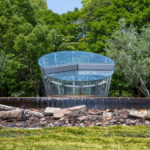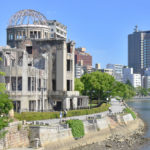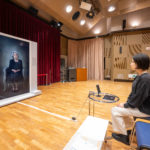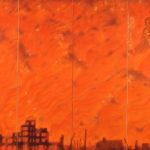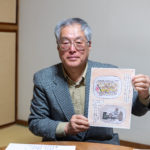SHODA Shinoe published a secret anthology of poems in the aftermath of the atomic bomb
Shedding light on SHODA’s courageous life and atomic bomb literature

SHODA Shinoe was a poet who evaded publishing restrictions immediately after the end of the war and published an anthology of poems entitled Sange that conveyed the reality of the atomic bombing. Sange was published in 1947, just two years after the atomic bomb was dropped. While publication of material about the atomic bombing was forbidden, 150 copies of the book were published in secret, circumventing the censorship of GHQ (General Headquarters of the Allied Forces). These copies are said to have been printed in Hiroshima Prison, despite the threat of severe punishment and the lack of assistance from anyone else.
Sange, The Love and Loneliness of the Atomic Bomb Poet SHODA Shinoe was published by the Association for Preservation of Literary Materials of Hiroshima in 1995. The book looks back on the life of SHODA Shinoe up until her death from breast cancer caused by the bomb. It features a variety of poems, including poems about the devastation of the atomic bomb (which are also included in Sange), vignettes of the author’s daily life, and poems about people who were close to her.
TSUCHIYA Tokiko, representative of the Association, explains the background to the publication of the book and atomic bomb literature in general, as well as the Association’s initiatives to preserve valuable literary materials that are in danger of disappearing.
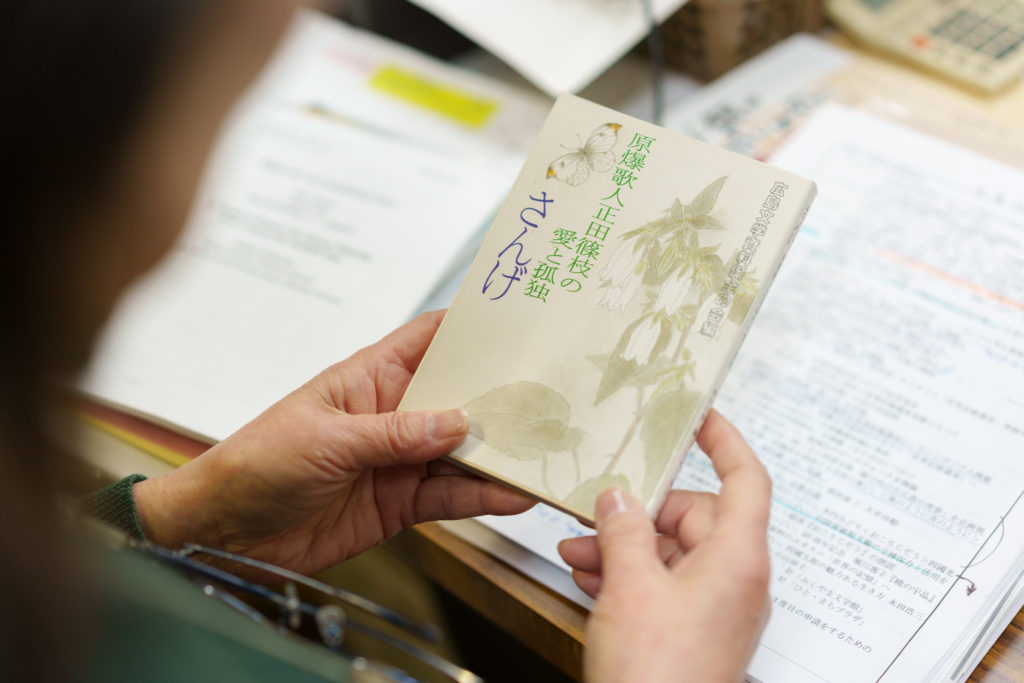
Around 500 copies of the book were self-published by the Association. There are currently only a few copies remaining which can be purchased from the Association’s website.
“The book was published in commemoration of the 50th anniversary of the atomic bombing. The book was written mainly by KOURA Chihoko, the first representative of the Association for Preservation of Literary Materials of Hiroshima and a close friend of Ms.Shoda, and members of the Association assisted with editing it.”
SHODA’s poems were written in the immediate aftermath of the bombing and describe the devastation and people’s situation around her, her grief over those who had lost their lives, and the sorrow and anguish of those who survived. One of her most well-known poems is called Futoki hone no uta (Poem of the Thick Bone). This poem is also inscribed on the pedestal of the Monument of the A-bombed Teachers and Students of National Elementary Schools in Hiroshima Peace Memorial Park.
“The thick bone must be a teacher
The small skulls beside it students gathered around.”
“The preliminary version of the text had 大き骨 (“large bone”). The poet herself changed this to 大きい (“large”), but subsequently deleted “い” and added the dot to “大” to make the character “太” (“Thick”).”

On the handwritten manuscript of the poem, we can see that the dot in “太” was added later on and “い” crossed out in ink.
This episode gives us a glimpse of SHODA’s perceptive capabilities for transcribing what she saw and experienced into words, as well as her dedication to the skill and craft of tanka (short format poems), even if she didn’t enjoy much of a literary reputation at the time.
“In the world of tanka, where the subject matter is typically flowers, birds, the wind or the moon, SHODA’s tanka, which were the first to deal with the atomic bomb, were considered highly unorthodox and “not proper tanka.” She was fighting cancer while she wrote. It is as if she kept on writing even as she was coughing up blood, so naturally, this is not ordinary literature. Atomic bomb writers remained obscure and unappreciated. This is still the case, even today. In 2001, an exhibition entitled Atomic Bomb Literature Exhibition: Five Writers of Hiroshima was held, featuring the literary materials of KURIHARA Sadako, HARA Tamiki, TOGE Sankichi, OTA Yoko, and SHODA Shinoe. This exhibition was very well-received. During their lifetimes, these five authors appear to have kept in contact and helped each other as friends in the writing of atomic bomb literature.”
The materials left by the authors of atomic bomb literature, who all ended their lives in obscurity, are in danger of being lost. Many works are out-of-print, and valuable originals and related materials have disappeared and become illusory.
“The Association has helped to organize a collection of material by TOGE Sankichi, HARA Tamiki, SHODA Shinoe, and others at Hiroshima City’s Central Library. The quality of paper at the time was poor, so the manuscripts and various materials were already falling apart. Tamiki Hara’s Notes of the Atomic Bombing has been digitized and posted on the Association’s website, but I think it’s important to preserve the originals properly since they are written in pencil and are no longer legible.”
The Association for Preservation of Literary Materials of Hiroshima was established in 1987 with the aim of collecting and preserving materials related to the literature of Hiroshima in general. In addition to independently collecting materials and working to preserve atomic bomb literature for example by digitizing it, since its establishment it has also been active in calling for the opening of a Hiroshima literature museum.
In January 2024, Hiroshima City announced plans to create a facility to house historical materials of the Asano family, the ruling samurai clan of the Hiroshima domain, as well as writings, manuscripts, and letters by writers associated with Hiroshima. The opening of this facility is scheduled for 2029 and it looks like the museum of literature, which has been a long-held dream of the Association, will finally become a reality.
“Once the museum of literature is established, I expect there to be an increase in the variety of materials available, and I hope that the number of researchers will also increase. There’s a limit to what we can do ourselves, so I hope that Hiroshima City will preserve these materials and make them readily available. There are many people all over the world who are interested in atomic bomb literature. Hiroshima was the first populated town to be exposed to an atomic bomb. The city has left us a body of literature that describes circumstances that are hugely significant for all humankind, and I hope it will be cherished as such.”
[Contact]
Association for Preservation of Literary Materials of Hiroshima
https://bungakuhozen.jimdofree.com/
082-291-7615
Tags associated with this article



